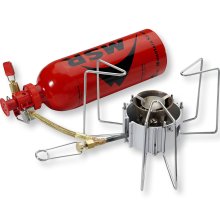by Bob Geier
There are advantages to "plop" camping. There are even uses for "plop" fixed-base camping for high adventure kids; we've done it for climbing (camp at one spot, go out on climbs), whitewater (base camp and day trip different rivers depending on water level and skill growth), skiing (base camp and work on telemark skills), etc.
While there are advantages to "plop" camping, there are no advantages to "plop" camping equipment. It is heavy. It is difficult to pack, so it requires large cars or dedicated trailers. It is expensive. Its use is limited to "plop" camping, which requires that you either duplicate gear for other types of outings, or never do other types of outings.
A Scout is Thrifty. By going with high-quality lightweight gear, you buy one set of things that has multiple uses, and is easier to pack and manage for trips. You get freedom to do trips of all sorts easily; your kids use the same familiar stove at the summer car campsite and in the ski-backpackers snow kitchen.
It took us time to change. Now I'm the only old fart who remembers the days of chuck boxes and large canvas dining flies. The kids don't even really believe me when I tell them about the "old days." "Yeah, right... hauling big wooden boxes into the field. Nobody'd be that silly."
Those same kids can set up camp and cook a meal in less than half the time as the old days, with less than half the effort... whether backpacking, canoeing, or "plopping."
In our outfitting, Patrols have 2-man lightweight tents, a large lightweight "Thelma" fly, and a Cook Group Kit of one stove, pot set, fry/bake pan, spice kit and bake kit for every 3-4 people (See: Cook Group Kits).
Boys bring their own personal "ditty bag" of eating-wear, consisting of a plastic bowl, insulated mug, and spork (along with whatever knife they generally use).
| OLD STYLE | LIGHTWEIGHT STYLE |
|
|
|
|
Whole Patrol lugs canvas fly to site. Spends at least half an hour with 8 people setting up poles, spreading fly, pounding stakes with hammer, running lines. |
Patrol dispatches 2 people to rig lightweight fly in 10 minutes, if desired. Meanwhile everyone has their tent set up and stuff secured.
|
| Two people lug wooden Patrol Box
to site and set up (despite bruised fingers). Additional person lugs
propane. One more lugs stove & connectors box. Young Scout carries
lantern and propane "tree." Setup requires about 1/2 hour total,
if they can find the wrench.
|
Boys pack their "Cook Group Kit" in their personal gear, or in a plastic box 1 boy can carry. Setup requires 1 boy, takes 5 minutes (10 if they have to figure out who's got the spatula). |
| Boys lug 3 big metal tubs for
water to clean with. They have to build a fire or burn lots of propane to
heat water. Younger scouts are assigned cleaning duty for all, including
plates, pots, etc. They finish securing the kitchen almost an hour after
the water is heated.
|
Cook throws hot water on as soon
as meal prep is done; cook (or helper) cleans common pots, each boy cleans
his own eating wear. Done in about 10 minutes if nothing's burned on.
|
| Boys start fire, wait until it
burns to coals, prep big cast iron Dutch oven, put
in coals, wait for hunk of iron to heat up, etc.
|
Boys mix cake mix, put in fry/bake pan, get out bake kit, start baking immediately. They finish cleanup before the old style group has the fire ready. |
On a good day, I think we can have camp set up, dinner cooked and cleaned, and camp secured in less time than it took to set up camp in the old system.
One thing that you have to watch is that 4 people is a "max" per lightweight stove. We have 2 and occasionally 3 stoves per Patrol, which may be used as separate "Cook Groups" within the Patrol, or combined to work together on something. But you need never to violate the "no more than 4 people per burner & gear" rule.
There's no reason why backpack stoves should mean any reduction in meal quality, unless it's because you're going to more cool places and doing so much cool stuff you have less time for cooking.
We never use those silly freeze-dried backpacker meals (very expensive and taste like latrine leftovers).
We've had guys prepare gorgeous 4 and 5-course meals, and we adults do that on a regular basis! Crab cake appetizer, a light lobster bisque, beef Wellington with mashed potatoes and green beans, topped off with a German chocolate cake (featuring Michigan cherries, of course) is quite straightforward. Homemade (in-the-field) yeast bread and yeast-dough pizzas are seen on occasion (even 30 miles away from the nearest car).
 Lightweight
"Cook Group" Patrol Cooking
Lightweight
"Cook Group" Patrol Cooking